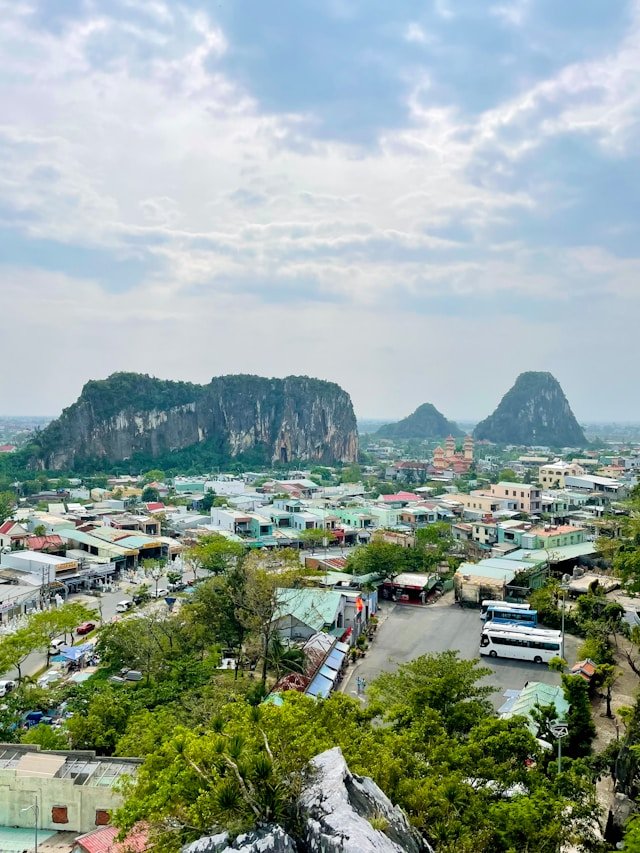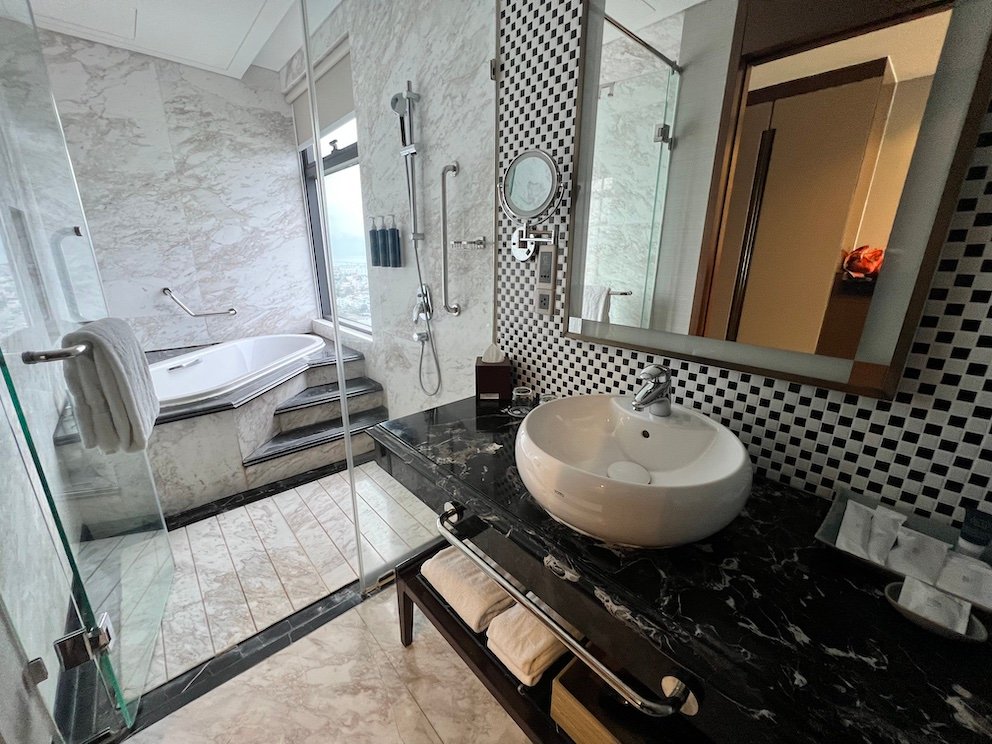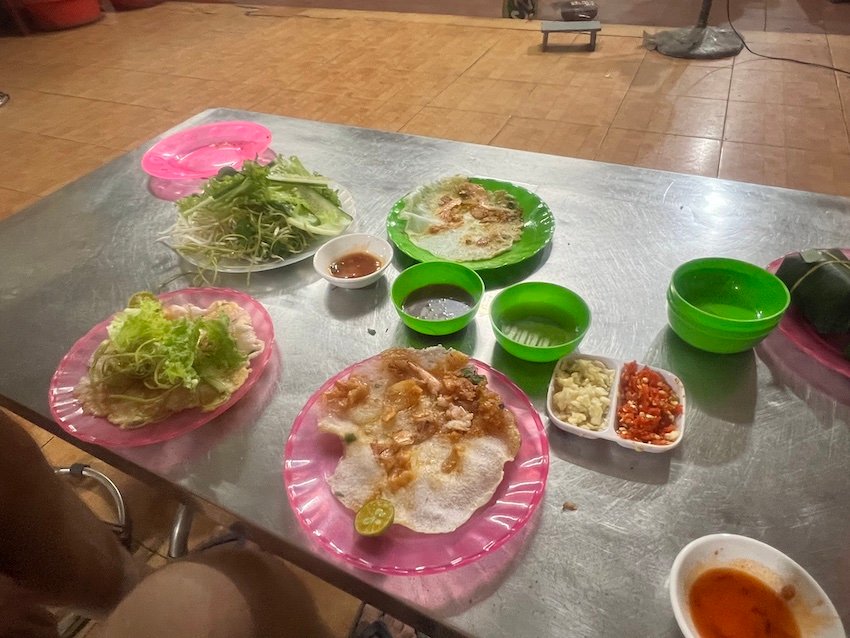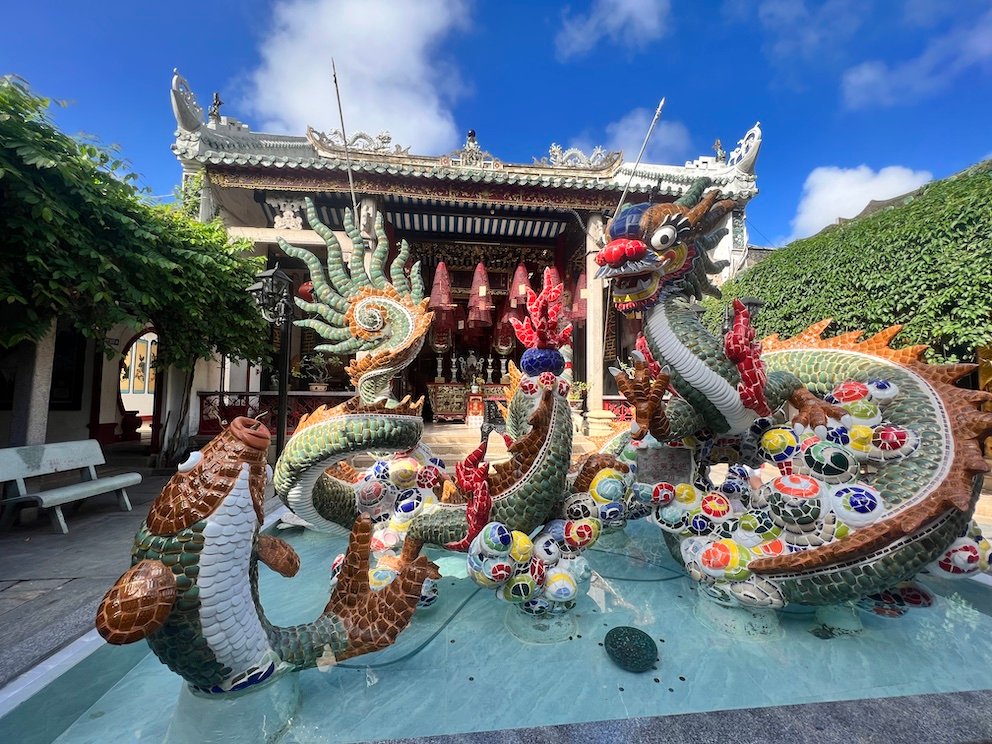After having travelled overland through Northern Thailand and Laos, it was finally time to take a short flight to my next stop in SE Asia: Vietnam. I had travelled extensively in Vietnam in the past, but have not travelled in the country’s scenic north and cultural central regions as much as I would have liked. My parents are from Vietnam, and I have always felt a strong tie to the country – from the amazing food, diverse cities, stunning natural landscapes to its resilient and beautiful people – there was always an indescribable magic to this country. This blog post will outline an itinerary through North and Central Vietnam in 3 Weeks.



Content:
- Itinerary
- Hanoi
- Cat Ba Island
- Sa Pa
- Hue
- Hoi An
- Da Nang
- Trip costs for 3 weeks in North and Central Vietnam
- Final thoughts
This post includes affiliate links. If you make a purchase via one of these links, I may receive a small percentage at no extra cost to you.
Itinerary:
I started my 3 week trip in North and Central Vietnam in Hanoi, where I met up with Jens. From Hanoi, we headed to Cat Ba Island via a bus + boat transfer to Cat Ba Island. We spent 4 days on Cat Ba Island, and then took the boat + bus transfer back to Hanoi, and then took the overnight sleeper train from Hanoi to Sapa. We spent 5 days in Sapa, then took the overnight sleeper train back to Hanoi where we stored our luggage at the train station and explored the city for a day before taking a flight to Da Nang. From Da Nang airport we got a transfer service to Hue, where we spent 3 days. From Hue we took a train to Hoi An, where we spent 4 days, and then took a transfer service to Da Nang where we spent one day before taking a flight up to Hanoi, where we spent 1 night before we took our respective flights out of Hanoi.
Day 1 – 2: Hanoi
Day 3: Travel from Hanoi to Cat Ba via a bus + ferry transfer
Day 4 – 6: Cat Ba Island
Day 7: Travel day from Cat Ba to Hanoi, then overnight train from Hanoi to Sapa
Day 8 – 11: Sapa, trekking and homestay
Day 12: Day in Sapa, and then overnight sleeper train to Hanoi
Day 13: Day in Hanoi, then flight to Da Nang and transfer from Da Nang airport to Hue
Day 13- 15: Hue
Day 15 – 18: Hoi An
Day 18 – 19 Transfer to Da Nang and stay one night
Day 19 – 20: Flight from Da Nang to Hanoi, where we stay one night before our exit flights

As you can see from the itinerary, we were in and out of Hanoi a lot. This was by design. Both of us had our entry and exit flights from Vietnam out of Hanoi, and to visit Sa Pa and Cat Ba in the North – we have travel through Hanoi to get from one of those destinations to the other. Hanoi also had the only major airport in Northern Vietnam, so to take our flights into Central Vietnam, we again would have to make our way to Hanoi – so it just made sense to make the city a kind of base camp for a lot of our travel.
Hanoi:
The busy capital of Hanoi, is known for famous landmarks like the Imperial Citadel of Thang Long, the Ho Chi Minh Mausoleum, and the Tran Quoc Pagoda. Neighborhood’s in the city are arranged by trade – ie: the silk street for silk goods. French and Chinese architectural influences – reflective of the nation’s colonial history – can be noted throughout the city.

The cultural heart of Hanoi revolves around Hoan Kiem Lake (“Lake of the Returned Sword”) in the Old Quarter of the city. The folkloric legend of the Vietnamese Emperor Le Loi leading a successful revolt against the invading Chinese in the 15th century centers around Hoan Kiem lake, where it is said that while boating on the lake, the Emperor encountered a divine turtle who asked the emperor to return a magical sword that had been lent to him to defeat the Chinese, he did so, and then renamed the lake the lake of returned sword. Giant Hoan Kiem turtles – considered to be sacred – lived in the lake until 2016.




Other major tourist sites in Hanoi include: the Imperial Citadel of Thanh Long, the Ho Chi Minh Mausoleum, Ngoc Son Temple, Tran Quoc Pagoda and the Thanh Long Water Puppet Theatre.
We stayed on points at the Sheraton Hanoi Hotel, which was outstanding. The “Club Level” rooms give you access to the Club Lounge which includes breakfast, and an evening “happy hour” which features a complementary dinner buffet with open bar.


Cat Ba Island:
Cat Ba Island is the largest of 367 islands comprising the Cat Ba Archipelago in the world famous Halong Bay Area. The broader Halong Bay area actually comprises of three smaller bays including Halong Bay, Lan Ha Bay, and Bai Tu Bay.
The bay is named for the striking limestone islands that jut out of stunning emerald waters like the back of a dragon diving into the water. Halong Bay literally means “Descending Dragon” bay.


Halong Bay is the most famous of the three major bays, and is well-served by various tour agencies with a range of Halong Bay cruises ranging from basic to luxury.
While Lan Ha Bay is less famous than Halong Bay, the scenery is exactly the same. Lan Ha Bay is less crowded, and tours are typically less expensive than in Halong Bay. Jens and I did a great day trip from Cat Ba Island around Lan Ha Bay.
Cat Ba Town – perched around the edges of a beautiful crescent bay – is the major tourist hub on the island. There are several beautiful beaches that can be reached on foot, bicycle or motorcycle from the town. If you can ride a scooter or motorcycle, the old fortification of Cannon Fort is a magnificent viewpoint that is a short ride away from Cat Ba town. Keep an eye out for wild pigs that roam the area.

There’s a wide variety of dining options available in Cat Ba Town’s many restaurants, and markets. Fresh seafood is plentiful and there is a good range of dining experience ranging from backpacker fare, to exotic seafood.
Jens and I stayed at the Thu Ha Sea View hotel, and outstanding budget option right on Cat Ba Bay with panoramic ocean views from our room. Our 4 night stay cost less than $30USD (Winter 2022 prices).



Sa Pa:
Located near Vietnam’s Northern border with China’s Yunnan region, stunning Sa Pa is a unique area of Vietnam where the indigenous peoples of the region have managed to preserve many of their cultural practices and traditions.
The region is famous for its rice terraces – which turn an impossibly vibrant green during the wet season – and are still impressive even after the harvest.

Trekking and hiking expeditions in Sa Pa – typically led by a local indigenous guide are a hallmark activity to do in Sa Pa among tourists, and is a great way to get to know some of the local people who live in the region as well as support indigenous communities. Jens and I did a 4 day 3 night trek from Sa Pa town into the Muong Hoa Valley with an indigenous guide. We stayed in various indigenous villages including with the Red Dao and Hmong peoples who lived in the area. If you’re short on time, there are also 3-day and 2-day treks available.







Beautiful Mount Fansipan is the highest mountain in Vietnam, and is also a popular destination for tourists who wish to hike to the top. Treks to the top of Fansipan can be done in 2 days, or for those who are very fit, in 1 day. There is also a cable car for those who prefer not to trek up and down.



When you’re in the Sa Pa region there’s also a famous 3-4 day motorcycle route called the Ha Giang loop that you can do from the town of Ha Giang. There are daytime and sleeper bus options to take you from Sa Pa to Ha Giang. While you can do this loop on your own if you know how to ride a motor bike, and it is also possible to hire a guide to drive you on a motor bike around the loop. Jens and I did not make time to do the loop – as we were partially afraid of the logistics of doing the route on our own – I only found out you can hire a guide after our trip.




The majority of our accommodations in Sa Pa were covered by our trekking excursion, but we did spend a night at ChienDe Homestay near Cat Cat Village, as well as at the Dang Khoa Sa Pa Hotel in Sa Pa Town before and after our trekking excursion. Both properties were excellent budget properties (Private rooms for around $10 – 15USD)





Da Nang:
Da Nang is the major commercial and transport hub for Central Vietnam. The region’s major international airport is here, and the pretty oceanside city is increasingly popular among foreign expats. Da Nang’s location between the two Central Vietnamese cultural capitals of Hue and Hoi An, makes it a convenient stopping point for a visit.
As the surf capital of Vietnam, Da Nang has a very different feeling than most other cities in the country. The city’s long beachside boulevard and waters dotted with surfers – feels more like Los Angeles, than any other city I visited in Vietnam.




Aside from the beach, the ever-Instagrammed Ba Na Hills featuring a giant set of hands holding a bridge, as well as the Marble Mountains towards the inland are major sites in Da Nang. Ba Na Hills and the Golden Bridge can be visited on a day tour from Da Nang. The Marble Mountains can be visited on a day tour that also visits the nearby Am Phou caves and Monkey Mountain.
Jens and I stayed on points at the Four Points by Sheraton Da Nang Hotel close to the beach. The property was excellent and featured a stunning pool area, as well as free bicycle rentals which Jens and I used to ride around town.




Hue:
The central Vietnamese city of Hue has a rich history from its roots as a prefecture of the Champa Kingdom – before the Vietnamese took over the region. From 1788 to 1801, Hue was the administrative capital of the Tay Son Dynasty, before it was captured by the Nguyen Lords who unified the Vietnamese monarchy – using Hue as the Imperial capital. This period was the last age of monarchy in Vietnam which lasted from 1802 to 1945. In the 1880s, Hue became the seat of the French Protectorate over Central Vietnam which is why there is still a fascinating French influence that still exists throughout the city today.

Major tourist destinations include the Imperial Citadel, and the surrounding old city of Hue. You can visit the Imperial Citadel on your own, or hire a private guide or join a guided tour to learn about the sprawling landmark in greater detail. Aside from the Imperial City, you can visit other landmarks in Hue on your own, or join this popular guided motorbike tour with a local student who will take you around major points of interest in Hue that would be difficult to get to on your own along with local commentary.





There’s an incredible food scene in Hue, as well as a thriving coffee culture. Take time to just enjoy sitting at one of the many cafes in the city. “Salt Coffee” – a born in Hue sweet coffee invention is a must-try when visiting the city. Staying near the Imperial City is a great bet, as it is not only close to the old monuments, but also a picturesque area full of cafes, restaurants and other points of interest.
Hue is famous for unique Vietnamese dishes – the most famous of which is Bun Bo Hue – which is a beef and pork noodle soup complete with exotic cuts like pork hock, and bloodcake – it is amazing – and you definitely level-up in terms of adventurous eating with this dish – but be aware that it is considered a breakfast food, so many places stop serving it after 10am!


While Hue does not have a major commercial airport – Da Nang airport is less than a 2 hour drive away. You can book a transfer directly from Da Nang airport into Hue with drop-off at your hotel included.
If you are visiting Hoi An next – consider taking the train connection between Hue and Hoi An. The train ride is one of the most spectacularly beautiful routes in the country.

If you’re up for an adventure, you can take a popular motorbike transfer for Hue to Hoi An that passes the storied Hai Van mountain pass. Unlike riding a motorbike yourself, this transfer service includes a professional driver and also helps you transport your baggage between the two cities – so you’re not trying to manage your baggage on a bike. The full-service transport picks you up from your hotel in Hue and drops you off at your hotel in Hoi An, and includes lunch at a floating restaurant and a stop at the Marble Mountains, and a waterfall.
Le Robinet Homestay in the old district of Hue walking distance to the Imperial Citadel is an excellent budget accommodations option in the city.



Hoi An:
Just south of Da Nang is the beautiful city of Hoi An. A UNESCO Heritage site since 1999, the city contains a stunning mosaic of different cultural influences from Japanese, Chinese and European. A highlight of this cultural confluence can be seen in the covered Japanese Bridge – which is a centerpiece of the old town of Hoi An as well as in buildings like the Temple to the Sea Goddess – which features Chinese architecture.


Evenings in the historic district of Hoi An are iconic. Bustling riverside night markets are illuminated by hundreds of lanterns along the river. Take an evening boat ride along the river before or after dinner at one of the many eateries on either side of the river. Street food is also an excellent option.
There is a wealth of amazing activities that you can do in Hoi An. The My Son ruins from the indigenous Champa people can be visited on a day trip from Hoi An. You can try a river-to-table cooking class; or bring home a piece of Hoi An by making one of the beautiful lanterns that characterize the city in a lantern-making class.



Jens and I stayed at the centrally located Legend Connect Homestay ($12-$15USD/night) and loved it. The private rooms were spotlessly clean, had refrigerators, and the property loaned us bicycles to use for free during our stay! We rode the bicycles all around town to the beach.



Trip Costs for 3 Weeks in North and Central Vietnam (2 people):
Accommodations: $137.86USD*
Internal Flights: $109.46 USD
Transportation: $138.68USD
Excursions: $433.78USD
Food and Dining: $300USD**
Total for two people: $1139.78USD
Total per person: $569.89USD

*Note: Jens and I got our stays at the Sheraton Hanoi Hotel (3 nights) and the Four Points by Sheraton Da Nang hotel (1 night) free on points, plus we saved another 2 nights of accommodations by taking the overnight sleeper train from Sapa to Hanoi round-trip. Another 3 nights of accommodations were covered by our trekking excursion in Sapa. So cost reflects 10 nights of accommodations in private rooms.
**Jens and I had all our meals included during our 4 day trekking excursion in Sapa. We also had breakfasts included during many of our stays. We had club lounge access at the Sheraton Hanoi Hotel, and just had our dinners there in Hanoi.



Final thoughts on North and Central Vietnam in 3 weeks:
Visiting North and Central Vietnam in 3 weeks allowed Jens and I to visit vastly different cities, landscapes and ecosystems at a relatively comfortable pace. From the stunning limestone bays of La Ha and Cat Ba island, and staying with indigenous villagers in Sa Pa in the North; to surfing in Da Nang, and sipping salt coffee in the old Imperial Capital of Hue in Vietnam’s center; 3 weeks in North and Central Vietnam allowed us to explore at our own pace and also relax at the same time. North and Central Vietnam are still relatively inexpensive places to visit. Our 3 week trip cost less than $1200 for both of us (although being strategic about taking overnight transports helped us save both time and money). We had a number of nights covered by free hotel points, but quality budget accommodations in private rooms were very inexpensive regardless (typically around $10-$15 a night).


